
(a)
Interpretation:
The major product for the given reaction is to be predicted, and the complete, detailed mechanism for the same reaction is to be drawn.
Concept introduction:
In the case of an electrophilic
Answer to Problem 23.1P
The major product for the given reaction is
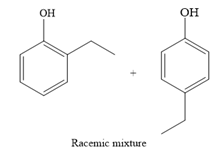
The complete, detailed mechanism for the given reaction is given below.
Formation of the electrophile:

Formation of the product (a racemic mixture of ortho and para isomer):
For ortho isomer:

For para isomer:
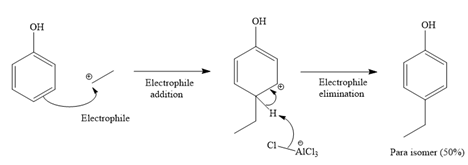
Explanation of Solution
The given reaction is

It is noticed that the given substrate, phenol, is treated with ethyl chloride in the presence of
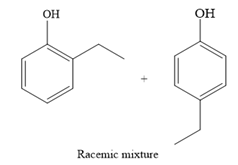
The mechanism for the given reaction is given below.
Since the given reaction is an example of an electrophilic aromatic substitution reaction, the first step is the formation of the electrophile as given below.
Initially, the electron-rich chlorine of the ethyl chloride is coordinated with an electron-deficient aluminum of

The formed electrophile, ethyl cation (
For ortho isomer:

For para isomer:
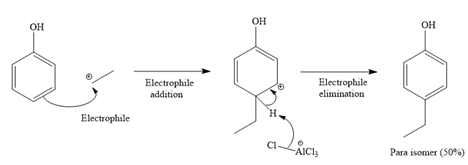
The major product for the given reaction is predicted, and the complete, detailed mechanism for the same reaction is drawn on the basis of the electrophilic aromatic substitution reaction.
(b)
Interpretation:
The major product for the given reaction is to be predicted, and the complete, detailed mechanism for the same reaction is to be drawn.
Concept introduction:
In the case of an electrophilic aromatic substitution reaction, a substituent influences the site of reaction. The electron-donating groups are ortho/para directing groups while electron-withdrawing groups are meta directing groups in the electrophilic aromatic substitution reaction. The Friedel-Crafts alkylation and acylation are an example of an electrophilic aromatic substitution reaction. The chlorination of the aromatic ring can be carried out by reacting with
Answer to Problem 23.1P
The major product for the given reaction is

The complete, detailed mechanism for the given reaction is given below.
Formation of the electrophile:

Formation of the product:

Explanation of Solution
The given reaction is
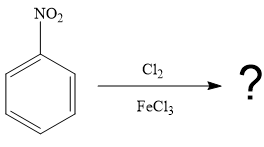
It is noticed that the given substrate is treated with

The mechanism for the given reaction is given below.
Since the given reaction is an example of an electrophilic aromatic substitution reaction, the first step is the formation of the electrophile as given below.
Initially, one of the electron-rich chlorine atoms of

The formed electrophile (

The major product for the given reaction is predicted, and the complete, detailed mechanism for the same reaction is drawn on the basis of the electrophilic aromatic substitution reaction.
(c)
Interpretation:
The major product for the given reaction is to be predicted, and the complete, detailed mechanism for the same reaction is to be drawn.
Concept introduction:
In the case of an electrophilic aromatic substitution reaction, a substituent influences the site of reaction. The electron-donating groups are ortho/para directing groups while electron-withdrawing groups are meta directing groups in the electrophilic aromatic substitution reaction. The Friedel-Crafts alkylation and acylation are an example of an electrophilic aromatic substitution reaction. The chlorination of the aromatic ring can be carried out by reacting with
Answer to Problem 23.1P
The major product for the given reaction is

The complete, detailed mechanism for the given reaction is given below.
Formation of the electrophile:

Formation of the product (a racemic mixture of ortho and para isomer):
For ortho isomer:

For para isomer:

Explanation of Solution
The given reaction is
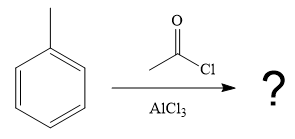
It is noticed that the given substrate, toluene, is treated with an acyl chloride in the presence of

From the Table 23-1, the product is a mixture of o+p isomer more than 95%.
The mechanism for the given reaction is given below.
Since the given reaction is an example of electrophilic aromatic substitution reaction, the first step is the formation of the electrophile as given below.
Initially, electron-rich chlorine of the ethyl chloride is coordinated with an electron-deficient aluminum of

The formed electrophile, acylium cation, then undergoes electrophilic addition to the benzene ring, followed by electrophilic elimination mechanism, to form the ortho and para isomers shown below:
For ortho isomer:

For para isomer:

The major product for the given reaction is predicted, and the complete, detailed mechanism for the same reaction is drawn on the basis of the electrophilic aromatic substitution reaction.
(d)
Interpretation:
The major product for the given reaction is to be predicted, and the complete, detailed mechanism for the same reaction is to be drawn.
Concept introduction:
In the case of an electrophilic aromatic substitution reaction, a substituent influences the site of reaction. The electron-donating groups are ortho/para directing groups while electron-withdrawing groups are meta directing groups in the electrophilic aromatic substitution reaction. The Friedel-Crafts alkylation and acylation are an example of an electrophilic aromatic substitution reaction. The chlorination of the aromatic ring can be carried out by reacting with
Answer to Problem 23.1P
The major product for the given reaction is
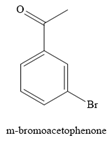
The complete, detailed mechanism for the given reaction is given below.
Formation of the electrophile:

Formation of the product:

Explanation of Solution
The given reaction is
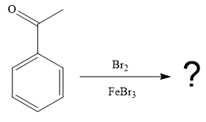
It is noticed that the given substrate is treated with

The mechanism for the given reaction is given below.
Since the given reaction is an example of an electrophilic aromatic substitution reaction, the first step is the formation of the electrophile as given below.
Initially, one of the electron-rich bromine atoms of

The formed electrophile (

The major product for the given reaction is predicted, and the complete, detailed mechanism for the same reaction is drawn on the basis of the electrophilic aromatic substitution reaction.
Want to see more full solutions like this?
Chapter 23 Solutions
ORG.CHEM W/TEXT+SOLU.MANUAL
 ChemistryChemistryISBN:9781305957404Author:Steven S. Zumdahl, Susan A. Zumdahl, Donald J. DeCostePublisher:Cengage Learning
ChemistryChemistryISBN:9781305957404Author:Steven S. Zumdahl, Susan A. Zumdahl, Donald J. DeCostePublisher:Cengage Learning ChemistryChemistryISBN:9781259911156Author:Raymond Chang Dr., Jason Overby ProfessorPublisher:McGraw-Hill Education
ChemistryChemistryISBN:9781259911156Author:Raymond Chang Dr., Jason Overby ProfessorPublisher:McGraw-Hill Education Principles of Instrumental AnalysisChemistryISBN:9781305577213Author:Douglas A. Skoog, F. James Holler, Stanley R. CrouchPublisher:Cengage Learning
Principles of Instrumental AnalysisChemistryISBN:9781305577213Author:Douglas A. Skoog, F. James Holler, Stanley R. CrouchPublisher:Cengage Learning Organic ChemistryChemistryISBN:9780078021558Author:Janice Gorzynski Smith Dr.Publisher:McGraw-Hill Education
Organic ChemistryChemistryISBN:9780078021558Author:Janice Gorzynski Smith Dr.Publisher:McGraw-Hill Education Chemistry: Principles and ReactionsChemistryISBN:9781305079373Author:William L. Masterton, Cecile N. HurleyPublisher:Cengage Learning
Chemistry: Principles and ReactionsChemistryISBN:9781305079373Author:William L. Masterton, Cecile N. HurleyPublisher:Cengage Learning Elementary Principles of Chemical Processes, Bind...ChemistryISBN:9781118431221Author:Richard M. Felder, Ronald W. Rousseau, Lisa G. BullardPublisher:WILEY
Elementary Principles of Chemical Processes, Bind...ChemistryISBN:9781118431221Author:Richard M. Felder, Ronald W. Rousseau, Lisa G. BullardPublisher:WILEY





